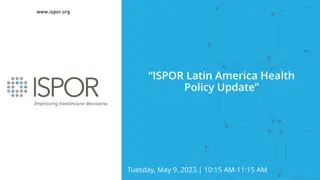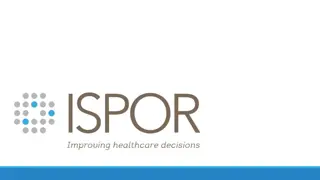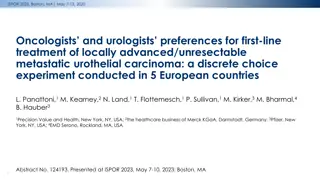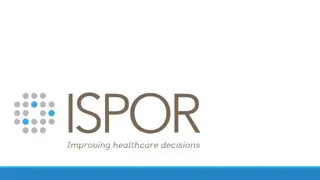
Understanding Health Technology Assessment (HTA) and Its Framework
Explore the concept of Health Technology Assessment (HTA) and its significance in healthcare decision-making. Learn about micro-level and macro-level HTA, the definition of health technology, and the assessment of added value in health technologies.
Download Presentation

Please find below an Image/Link to download the presentation.
The content on the website is provided AS IS for your information and personal use only. It may not be sold, licensed, or shared on other websites without obtaining consent from the author. If you encounter any issues during the download, it is possible that the publisher has removed the file from their server.
You are allowed to download the files provided on this website for personal or commercial use, subject to the condition that they are used lawfully. All files are the property of their respective owners.
The content on the website is provided AS IS for your information and personal use only. It may not be sold, licensed, or shared on other websites without obtaining consent from the author.
E N D
Presentation Transcript
SANOFI EDUCTIONAL SYMPOSIUM 4 NOVEMBER 2019 Assessing value locally: A conceptual framework ohe.org Adrian Towse, Emeritus Director and Senior Research
Four OHE / UW HTA Reports (2011, 2012, 2017, 2017 ) Source: Acknowledgement to my colleagues at OHE and to Lou Garrison and his colleagues at UW. All errors are mine! Source:
Agenda SANOFI EDUCATIONAL SYMPOSIUM 4 NOVMBER2019 What exactly is HTA? Macro and micro HTA A conceptual model Natural history of HTA development HTA good practice The importance of governance and process Two Poles on HTA Methods Continuum Back to macro and micro decision making Five Key Observations on HTA Challenges x2 3
What exactly is HTA? HTA is an evidence-based, multidisciplinary process intended to support healthcare decision making by assessing properties and effects of one or more new or existing health technologies in comparison with a current standard. Aiming at determining added value, HTA uses explicit analytical frameworks based on research and the scientific method in a systematic, transparent, unbiased way. What Is Health Technology? A health technology is defined as an intervention that may be used to promote health, to prevent, diagnose or treat acute or chronic disease, or for rehabilitation. Health technologies include pharmaceuticals, devices, procedures, and organizational systems used in healthcare. Examples of health technology: Diagnostic and treatment procedures Medical equipment Pharmaceuticals Rehabilitation and prevention methods Organizational and supportive systems within which healthcare is provided Information and communication technologies Sources: EUnetHTA, WHO, INAHTA
Micro-level and Macro-level HTA Micro-level HTA focuses on technologies such as drugs and devices that are considered to be incremental to the health system aimed at developing clinical practice guidelines or the way in which individual technologies are combined within a delivery system to manage patients efficiently Macro-level HTA focuses on elements of the architecture or framework of health system in general, such as the number, types, and mix of health care facilities and health workers in the system Priority-setting can be viewed as a type of macro-level HTA.
15 PRINCIPLES OF HTA: EMPHASIS ON PROCESS 9. Consider and Address Issues of Generalizability and Transferability 1. Goal and Scope Explicit and Relevant to Use 2. Unbiased and Transparent Exercise 10. Actively Engage All Key Stakeholder Groups 3. Include All Relevant Technologies 4. Clear System for Setting Priorities Should Exist 11. Actively Seek All Available Data 12. Monitor the Implementation of HTA Findings 5. Incorporate Appropriate Methods for Assessing Costs and Benefits 13. HTA Should be Timely 6. Consider a Wide Range of Evidence and Outcomes 14. Appropriately Communicate HTA Findings to Different Decision Makers 7. Consider Full Societal Perspective 15. Be Transparent and Clearly Define Link Between HTA Findings and Decision- Making Processes 8. Explicitly Characterize Uncertainty Surrounding Estimates Drummond MF, Schwartz JS, Jonsson B, Luce BR, Neumann, PJ, Siebert U, Sullivan SD. Key principles for the conduct of HTA for resource allocation decisions. International Journal of Technology Assessment in Health Care, 24:3 (2008), 244 258
TWO POLES ON HTA METHODS CONTINUUM Therapeutic Added Value (Non-QALY-Based) Flexible QALY-Based US: Decentralized; Little reliance on formal HTA and government outlaws QALY; BUT with I.C.E.R.-- Emergence of a value-based price (VBP) using the QALY, with several thresholds UK: Centralized, Formal QALY-Based Germany: Centralized, Focus on RCT-based relative clinical efficacy not QALY-based; Heavy reliance on formal HTA as stakeholder-driven, deliberative process; IRP as a back-up Australia: Centralized, No fixed QALY threshold; Rules of rescue in place Canada: Decentralised, CADTH analysis used by Provinces; No fixed QALY threshold France: Centralized, No fixed QALY threshold
Which macro-level decision making factors? *The arrow based representation of value is adapted from that used in the ICER Value Framework http://www.icer-review.org/wp- content/uploads/2014/01/Value_Assessment_Draft_Framework_Slides_07302015.pdf Towse, A., Devlin, N., Hawe, E., Garrison, L., 2011. The Evolution of HTA in Emerging Markets Health Care Systems: Analysis to Support a Policy Response. OHE Consulting Report. London: Office of Health Economics.
Elements in a payer assessment of value Getting to Health System Value Affordability and Incremental value Context: Health System Intervention Value Comparative Clinical Effectiveness Additional Benefits Health System Value
UW-MSH Study: Five Key Findings on HTA Challenges 1. The use of HTA in the surveyed low- and middle-income countries is extremely limited for the most part. 2. There is a strong need for consensus building among the stakeholders and raising awareness of the importance and use of HTA, prior to starting a process to strengthen HTA 3. Building capacity and an increasing quantity and quality of human resources for HTA is critical. 4. It will be important to develop standards and policies to enforce the use of HTA. 5. Other than for regulatory review, micro-HTA is probably not that helpful or necessary in the absence of functioning public health insurance delivery and insurance system.
OHE Study: Five Key Observations on HTA Challenges 1. HTA may have a role in assisting the health care system to reconcile rapidly expanding demand with more slowly expanding resources in a more explicit and transparent way, and in promoting public debate about priorities. 2. HTA of individual technologies is not a substitute for the reform of health care systems. Where health care systems create obviously bad incentives, this type of micro-HTA is unlikely to compensate for these failings. 3. One size fits all HTA processes and methods are unlikely to be appropriate for emerging markets. There needs to be clarity over the purpose of HTA and the methods and processes which are adopted need to be fit for purpose. 4. HTA and pricing work hand in hand: the HTA approach should be appropriate to, and work sensibly in combination with, the particular approach to pricing. 5. The relevance and positioning of any role for HTA in a health care system depends on the development stage and structure of that health care system.
References [to follow] SANOFI EDUCATIONAL SYMPOSIUM 4 NOVMBER2019 Towse et al., OHE, 2011 Garrison et al., UW/MSH, 2012 14
To enquire about additional information and analyses, please contact: Adrian Towse atowse@ohe.org OHE Southside 105 Victoria Street London SW1E6QT UnitedKingdom Telephone +44 (0)20 7747 8850 To keep up with the latest news and research, subscribe to our blog. OHE s publications may be downloaded free of charge from our website. FOLLOW US ohe.orgohe.org






